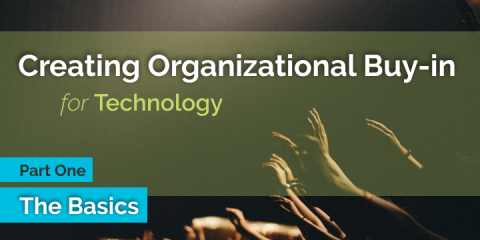The Basics

Gaining organizational buy-in for change can be difficult, but it doesn’t need to be. We’ve broken down our most recent training webinar into a three-part post series where three experts who have gone through the technology implementation process share how they helped bring and spread the use of technology supports within their own organizations. In part one of the series, The Basics, experts cover the basic steps needed to bring forward technology supports as a valid option for your organization and the individuals you help support based on their experiences.
Get to know the experts:
 |
Sean Henderson, Information Systems Analytics Manager Hammer Residences |
 |
Kathy Larson, Director of Brain Injury and Specialty Support Services REM Minnesota |
 |
Kit Piltingsrud, Program Manager and Assistive Technology Professional Living Well Disability Services |
Get Educated
The first step to gaining buy-in from others is being able to articulate why you believe in something, and why it’s a good choice.
- Identify what you are trying to solve for, keeping the individual at the center. Assessment guides are great options to get you started.
- Research possible solutions or next steps. A great place to start is the Technology Resource Center Library, which includes success stories, specially designed resources, and helpful links from around the web.
- Find out what costs might be involved. Research possible solutions online and/or request information from tech vendors or peers. TRC Mentors are great resources to reach out to—they’ve been through this process before, and are ready to help.
Hear from the experts and utilize the resources below:
Bring it Forward
Now that you have identified the need, a potential solution, and rough costs associated, you can bring your plan forward to your supervisor or key stakeholders further explaining why you believe this to be a great solution for the individual, and for your organization.
- Highlight the benefits of technology use (autonomy, decrease in staff hours, increase in staff efficiency, etc)
- Share examples. Show examples of supports actually helping people to gain buy-in and excitement.
Hear more from the experts:
Spread the Knowledge
Now that you’ve got the attention of your boss and/or key stakeholders, further develop your case for technology and begin sharing concepts with others in your organization and the people you help support.
- Bring in the experts for a “show-and-tell” experience. Many vendors offer free demos.
- Use tech-solve language or terms around co-workers, individuals, and families to familiarize them.
- Have open discussions with primary care staff to determine real needs/wants and promote innovation.
In part two and part three of the series, experts will dive deeper into ways to spread the knowledge throughout your organization to create buy-in. Concepts include ways to educate all members of the care team, maintaining support, and how to become the champion for technology use within your organization. Stay tuned!
Don’t miss the next article!
Visit the ARRM Technology Resource Center to learn about more success stories and case studies showing how technology is changing the lives of those living with disabilities or learn more about how to start the conversation.




